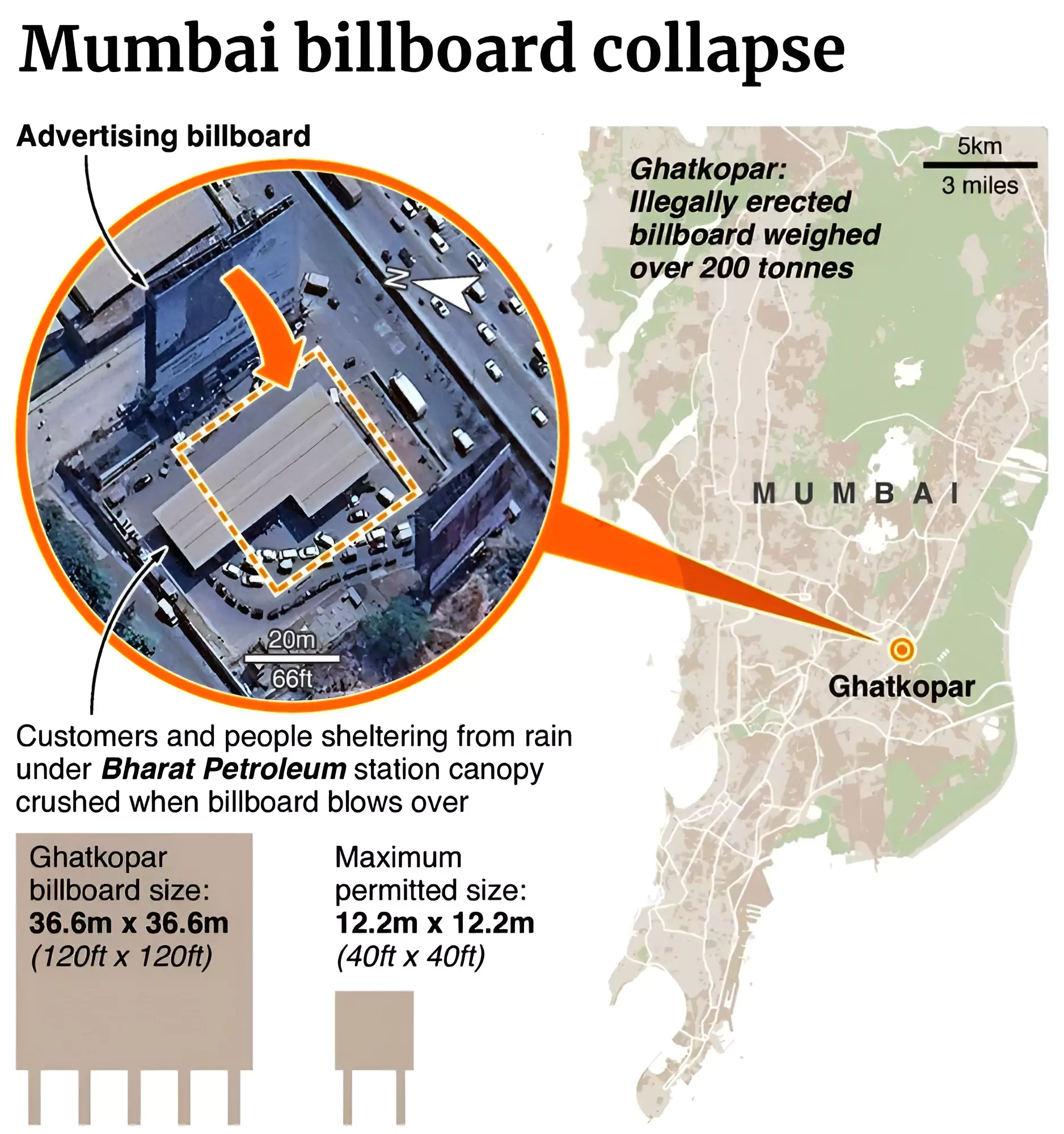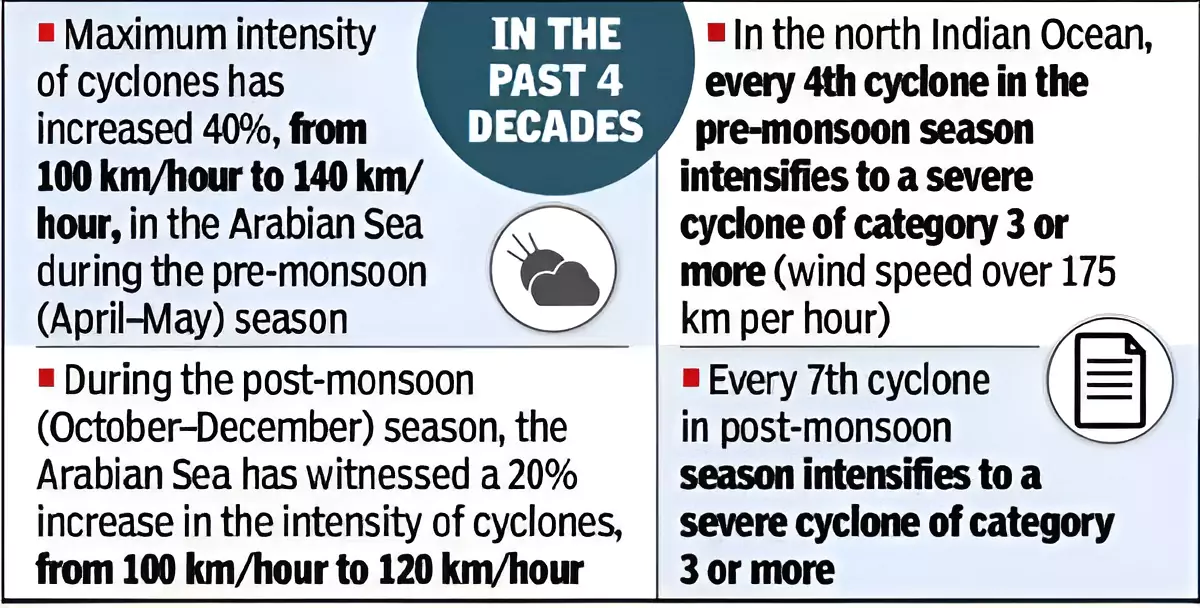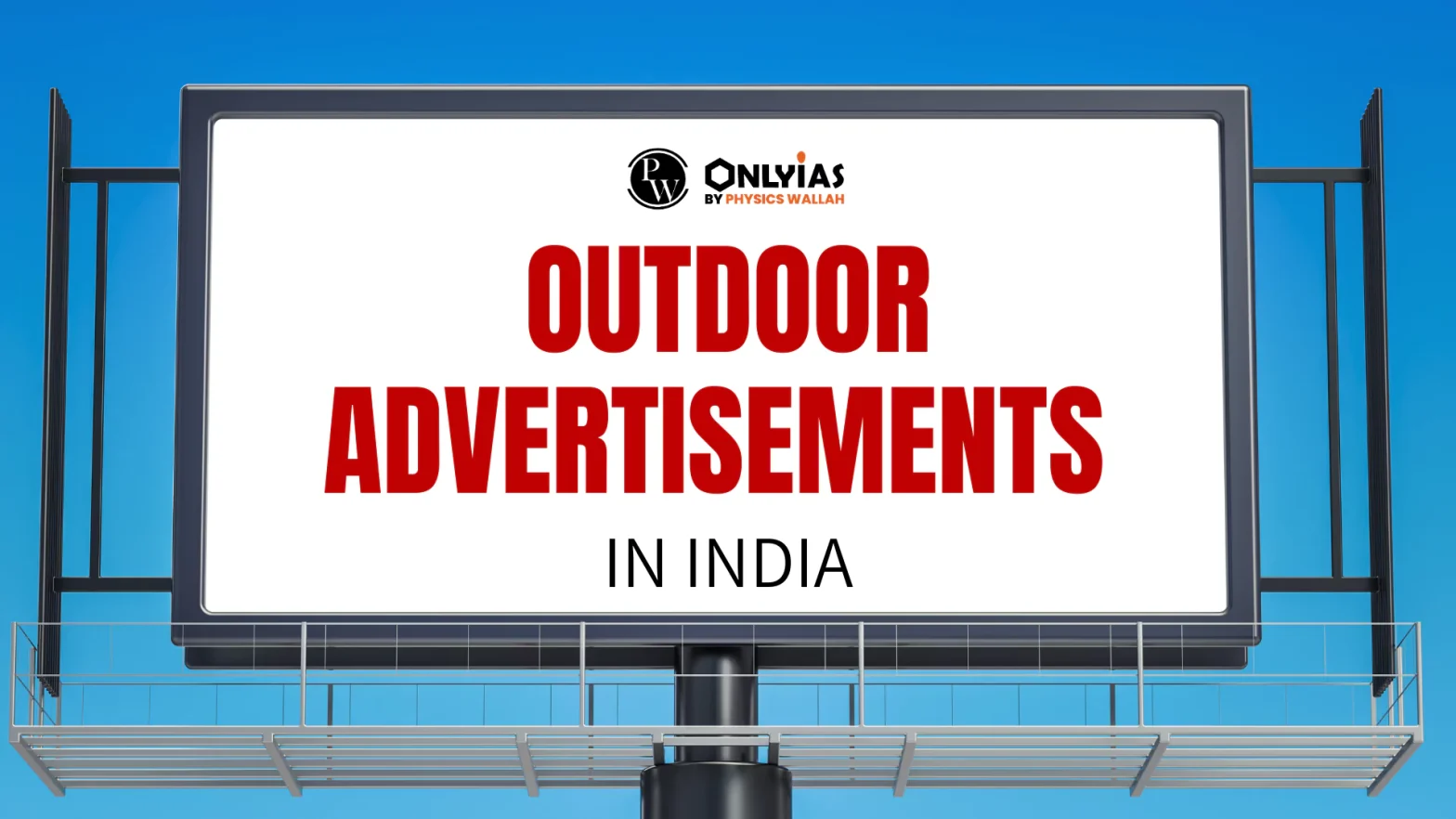Context
Recently, a giant outdoor hoarding/billboard collapsed in Ghatkopar, Mumbai in a widespread dust storm leaving at least 16 people dead and over 70 people injured.
Recent Incident of Hoarding Collapse

- Just days after this incident, a hoarding collapsed on on the Pune-Solapur highway, following rain, injuring an animal.
- In May 2023, in Pune, an unauthorized hoarding collapsed leaving five people dead.
- In June 2023, three workers were crushed when the huge hoarding that they were erecting collapsed at Thekkalur near Karumathampatti in Coimbatore district, Tamil Nadu.
Enroll now for UPSC Online Course
Reasons Behind Such Hoarding Accidents
- Violations of Dimensions: Although the policies provide for maximum dimensions for hoardings, many cities have billboards that are well beyond permissible sizes.
- A hoarding nine times the permissible size was allowed to remain until it collapsed indicates a lack of oversight on the part of the BMC.
- A review of outdoor advertisement policies across different cities in India shows that these policies have very little to offer with respect to time-bound action against illegal hoardings.
- Lack of Proactiveness: Information gathered from Mumbai’s observatories indicates that there were dangerous wind speeds at the time when the billboard collapsed.
- The authorities ignored the earlier incidents and did not learn a lesson from similar incidents in Pune (2017) and Pimpri-Chinchwad (April 2023).
- Lack of Enforcement: Policies and guidelines lay down safety requirements for outdoor advertising infrastructure, but periodic enforcement of these standards continues to be overlooked.
 There are two key issues that hinder the enforcement of advertising regulations by city corporations:
There are two key issues that hinder the enforcement of advertising regulations by city corporations:
- The lack of transparency and intermittent enforcement.
- There is no public database of permits for hoardings, indicating a lack of transparency in enforcement.
- Extreme Weather: The Mumbai hoarding collapse highlights the vulnerability of weak infrastructure to extreme weather events, such as cyclones and dust storms.
- Climate change is intensifying cyclones in the Arabian Sea, increasing the frequency and severity of such incidents.
- As per the Centre for Climate Change Research, a 20%-40% increase in cyclone intensity in the Arabian Sea over the past four decades.
- Others:
- There is a lack of manpower in municipalities to enumerate unlicensed hoardings, periodically inspect authorised billboards, and act against unstable or illegal ones.
- Many leaders, especially political leaders, encourage their larger-than-life projections on flex banners and illuminated cut-outs.
- All these made enforcing legal and all-weather structural stability requirements of billboards being ignored.
- Also, the legacy-style hoardings with inadequate foundations coexist with modern displays, particularly along highways and urban roads.
About Outdoor Advertisements
- Refers: Outdoor advertising is the publicizing of a business’s products and services to attract consumers’ attention when they are outdoors.
- This is also known as out-of-home (OOH) advertising.
- It is an effective strategy that organizations use to market their businesses to existing and potential customers.
- Classification: There are many different types of Outdoor advertising and they can be broadly classified into four main categories:
- Hoardings: These are also known as billboards, are generally located in high traffic areas such as along highways or near shopping malls to attract the attention of the highest number of drivers and pedestrians.
- It is effective at creating and boosting brand awareness as the ad is always visible 24×7.
- Its cost in India has no standard pricing and purely depends on the location and size.
- Street Furniture Advertising: This type of outdoor advertising is known as street-level urban media, it is placed at eye level for foot traffic and can be really attention grabbing for pedestrians as well as commuters.
- It includes news racks, mall kiosks, ATM kiosks, park benches and telephone booths.
- They are also fairly inexpensive and allow the advertisers a good scope to get creative with their ads.
- Transit Advertising: It refers to all kinds of advertising placed inside or on modes of public transportation such as bus shelter, airports, petrol pumps, train branding and train stations.
- It is one of the least expensive ways to advertise.
- Alternative/non-traditional Outdoor Advertising: There are also a lot of ever-growing alternate/non-traditional outdoor media options such as walking billboards, pole kiosks, hot-air balloons, sailboats and mall advertising.
- Favorable Factors: Rapid development seen in infrastructure, including upcoming airports, smart city projects, malls, metros, bus shelters, public conveniences, and coffee shops, along with increased advertising opportunities in Tier II and III cities is the major driver of the outdoor advertising market in India.
- During events like Diwali, IPL, elections, etc., the demand for outdoor media publicity increases as organizers try to get people’s attention to the event.
- Any event or festival, which is not a part of the yearly predictability and plan, is more beneficial such as general body elections which come once in five years.
 Significance: The advertising industry is one of the most important segments of the media and entertainment industries. Among its types, outdoor advertisements have been one of the fastest-growing segments in the advertising space of India.
Significance: The advertising industry is one of the most important segments of the media and entertainment industries. Among its types, outdoor advertisements have been one of the fastest-growing segments in the advertising space of India. -
- Outdoor advertising in India has a rich history dating back to the days of hand-painted billboards and painted signs on the sides of buildings.
- Over the years, the outdoor advertising sector has transformed into a sophisticated and diverse industry with different types of outdoor advertising in India being evolved.
- Challenges: The Indian outdoor advertising market faces challenges such as a lack of strong monitoring systems, the unorganized nature of the media, a lack of solid research to prove the effectiveness of outdoor advertising, a lack of transparency, and enormous market fragmentation.
Enforcement Mechanisms in India
- Issue of License: Local bodies issue licenses for advertisement hoardings, requiring approval from an executive authority.
- The Mumbai Municipal Corporation Act (MMC) of 1888: The MMC Act, 1888, specifically Section 328A, mandates written permission from the Municipal Commissioner for such structures.
- The 2018 Policy Guidelines for Display of Advertisements require structural stability certification from a registered engineer for hoardings.
- The Delhi Outdoor Advertising Policy, 2017: It requires that the owners of non-compliant advertisements be asked to remove the structure within a specified time, failing which they are to be removed by the municipal authority.
Enroll now for UPSC Online Classes
About the Bureau of Indian Standards (BIS):
- Setting Up: Set up under the Bureau of Indian Standards Act, 2016, it came into effect on 12 October 2017. The Act was originally enacted in 1986.
- The BIS was formerly called the Indian Standards Institution (ISI), set up under the Resolution of the Department of Industries and registered under the Societies Registration Act, 1860.
- Composition: The BIS consists of 25 members drawn from Central or State Governments, industry, scientific and research institutions, and consumer groups.
- The Minister in charge of the Ministry or Department having administrative control of the BIS is the ex-officio President of the BIS.
- Headquarters: The Headquarters of BIS is located in New Delhi, with regional offices at Kolkata, Chennai, Mumbai, Chandigarh, and Delhi.
|
-
- It also allows the suo motu removal of unauthorised devices that pose a hazard to road traffic.
- The Bruhat Bengaluru Mahanagara Palike Advertisement Rules, 2021: It is a more comprehensive enforcement regime but they were withdrawn after public backlash.
- The rules vested the Chief Commissioner with the power to remove unauthorised hoardings, and constituted an Advertisement Regulatory Committee to monitor compliance enforcement and the removal of unauthorised advertisements.
- The Tamil Nadu Urban Local Bodies Rules, 2023: It requires the municipal officials concerned to review the licensing of hoardings every three months and submit quarterly reports to the chief administrative officer of the urban local body.
- Technical Standards and Oversight: The Bureau of Indian Standards (BIS) provides specifications for wind loads on hoardings under IS875, Part 3.
- It includes formulas for calculating force coefficients for wind-facing structures.
Issues with Urban Governance in India
- Power Devolution: The 74th Amendment Act, 1992 requires state governments to devolve 18 functions, including land use regulation, to municipalities.
- But several studies, including a 2021 Niti Aayog report revealed that no state government has delegated all 18 functions to civic bodies.
- Overlapping of Jurisdictions: Urban local bodies are often constricted due to overlapping jurisdictions with other state agencies, leading to confusion and shifting of accountability.
- Example: There is much confusion amongst the city’s municipality, DDA and PWD over road maintenance.
- Fire accidents in most cities are followed by government agencies passing the buck to each other – much like the BMC and GRP evading responsibility for the Ghatkopar tragedy.
- Holding of Regular Civic Election: One of the fundamental purposes of the 74th Amendment Act was that citizens would turn to corporators the “first-mile” representatives to cater to civic needs. But the term of the BMC’s elected members expired about two years ago.
- Bengaluru, currently facing a severe water crisis does not have elected corporators.
- The failure of the state governments to hold civic body elections goes against the Supreme Court’s unequivocal directions in the Suresh Mahajan case (2022).
- The Supreme Court ordered that the State government and State Election Commissions (SEC) are obliged to ensure that a newly elected body is installed in all municipalities before the expiry of the five-year term of the outgoing council.
Way Forward
- Role by Municipal Authorities: Municipal authorities need to actively recognise their role in the removal of illegal outdoor advertisements and assume responsibility for the identification of unauthorised advertising structures.
- Municipal bodies need to institute proactive enforcement mechanisms, instead of taking action only in response to either court orders or harrowing incidents.
- The apathetic attitude of officials that compounds people’s problems needs to be changed.
- Appointment of Inter-departmental Bodies: Through the appointment of inter-departmental bodies, it could check on unauthorised hoardings by undertaking periodic zone-wise or ward-wise inspection of outdoor advertisements to ensure that they meet the standards laid down in law.
- Mandatory Inspection: The periodic inspections should be mandatory rather than a discretionary power of the municipal authority. Appointment of inter-departmental bodies will help in achieving this mandatory periodic inspection.
- Relevant Personnel: Such enforcement and monitoring bodies may include relevant personnel from the traffic department along with zonal- or ward-level officers of the corporations and departmental safety engineers.
- Identification & Enforcement: The unauthorised hoardings include not only durable installations but also unauthorised banners and flexes, which, despite being temporary, also pose a significant safety risk.
- For transparency, advertisement policies must expressly state the process through which complaints against illegal advertisements may be raised and the action to be undertaken.
- For intermittent enforcement, there is a need for a mechanism which ensures the prompt removal of unauthorised hoardings.
- Specify the Course of Action: City-level policies or bye-laws must also specify the course of action to be taken by corporation officials subsequent to the identification of unauthorised hoardings.
- Action must also be taken against officials who fail to remove illegal structures despite complaints.
- Use of Technology: Compliance may be monitored through the effective deployment of technology, such as the embossing of QR codes on all authorised hoardings.
- Corporations must also look towards creating platforms and mechanisms through which citizens may report violations.
- The digital boards display different advertisers to use the same screens to show messages.
- Documentation: International studies have pointed to billboards being dangerous distractions on roads as they affect a driver’s response time, vehicle lateral control and situational awareness. Hence, accidents caused by such distractions must be documented in the annual Road Accidents in India report.
- Sustainability: Environmental consciousness is influencing outdoor advertising. There is a need to explore more eco-friendly materials, energy-efficient lighting, and sustainable practices to minimize the environmental impact of their outdoor campaigns.
- For setting up a billboard, a proper study needs to be carried out to understand if the structure will be able to bear the wind-load when hoardings are erected on them.
- Cities need to reassess the safety of large outdoor structures in light of increasing extreme weather events.
Enroll now for UPSC Online Course
![]() 22 May 2024
22 May 2024


 There are two key issues that hinder the enforcement of advertising regulations by city corporations:
There are two key issues that hinder the enforcement of advertising regulations by city corporations:
 Significance: The advertising industry is one of the most important segments of the media and entertainment industries. Among its types, outdoor advertisements have been one of the fastest-growing segments in the advertising space of India.
Significance: The advertising industry is one of the most important segments of the media and entertainment industries. Among its types, outdoor advertisements have been one of the fastest-growing segments in the advertising space of India.